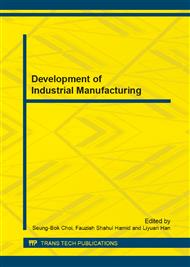p.320
p.325
p.333
p.337
p.342
p.346
p.351
p.355
p.363
The Structural Properties Research of Piezoelectric Cantilever Beam Based on Vehicular Environment
Abstract:
The piezoelectric power generating device can convert the vibration energy into electrical energy in vehicular environment. So it can provide energy for electronic components. Firstly, the mathematical model of road-vehicles-piezoelectric device coupled vibration was established under the random road excitation. Then vibration simulation analysis of the established model was made. The acceleration and spectrum of the vehicles body and its connection with the suspension were researched under B-class. The car body vibration is low-frequency vibration. Further studies shows that expanding the speed range and changing the roads level almost have no effect on the natural frequency of vehicles body vibration. Secondly, in order to make the maximum generating capacity, the influences of cantilever beam parameters have on its nature frequency were researched. The research results provide basis for parameters design in cantilever beam.
Info:
Periodical:
Pages:
342-345
Citation:
Online since:
February 2014
Authors:
Price:
Сopyright:
© 2014 Trans Tech Publications Ltd. All Rights Reserved
Share:
Citation:


